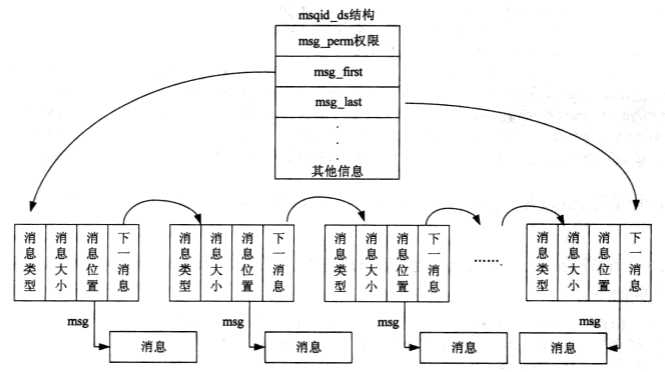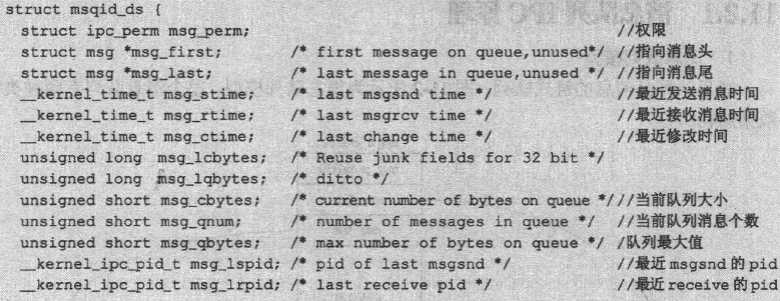消息队列 IPC 原理
消息队列是消息的链式队列,如下图为消息队列的模型。整个消息队列有两种类型的数据结构。

1.msqid_ds 消息队列数据结构:描述整个消息队列的属性,主要包括整个消息队列的权限、拥有者、两个重要的指针(分别指向消息队列的第一个消息和最后一个消息)。
2.msg 消息队列数据结构:整个消息队列的主体,一个消息队列有若干个消息,每个消息数据结构的基本成员包括消息类型、消息大小、消息内容指针和下一个消息数据结构的位置。消息队列还可以基于类型处理,但是,消息队列的 FIFO 原则仅仅适用于同类型的消息。在 Linux 中,对消息队列进行了以下规定(不同 Linux 版本的话值可能会不同):
1.默认情况下,整个系统最多允许有16个消息队列。
2.每个消息队列最大为16384字节。
3.消息队列中的每个消息最大为8192字节。这些内容在 /usr/include/linux/msg.h 中进行定义:
#define MSGMNI 16 /* <= IPCMNI */ /* max # of msg queue identifiers */
#define MSGMAX 8192 /* <= INT_MAX */ /* max size of message (bytes) */
#define MSGMNB 16384 /* <= INT_MAX */ /* default max size of a message queue */消息队列的基本属性
下图出于 /usr/include/linux/msg.h 文件

消息队列管理
1.创建消息队列:
#include <sys/types.h>
#include <sys/ipc.h>
#include <sys/msg.h>
/* 第一个参数为key值,一般由ftok()函数获得;第二个参数为访问权限 */
int msgget(key_t key, int msgflg);2.消息队列属性控制
#include <sys/types.h>
#include <sys/ipc.h>
#include <sys/msg.h>
/*
* 第一个参数为消息队列ID,由msgget获得
* 第二个参数为控制指令
* 第三个参数为数据传递的载体
*/
int msgctl(int msqid, int cmd, struct msqid_ds *buf);控制指令如下:

3.发送消息队列
#include <sys/types.h>
#include <sys/ipc.h>
#include <sys/msg.h>
/*
* 第一个参数为消息队列ID
* 第二个参数 msgp 指向定义的缓冲区
* 第三个参数为发送消息的大小
* 第四个参数一般高为0,阻塞调用进程
*/
int msgsnd(int msqid, const void *msgp, size_t msgsz, int msgflg);4.从消息队列接收消息
#include <sys/types.h>
#include <sys/ipc.h>
#include <sys/msg.h>
/*
* 第一个参数为消息队列ID
* 第二个参数为临时消息数据结构,用于储存消息
* 第三个参数为接收消息的大小
* 第四个参数用于指定请求的消息类型
* 第五个参数一般设置为0,阻塞调用进程
*/
ssize_t msgrcv(int msqid, void *msgp, size_t msgsz, long msgtyp, int msgflg);其中消息数据结构应定义如下:
/* From /usr/include/linux/msg.h */
struct msgbuf {
long mtype; /* 消息类型 */
char mtext[1]; /* 存储消息位置,需要重新定义 */
};消息队列应用实例
创建两个进程,使用消息队列进行通信,一个进程发送消息,另一个进程接收消息。
发送端:
#include <stdio.h>
#include <sys/types.h>
#include <sys/ipc.h>
#include <sys/msg.h>
#include <stdlib.h>
#include <string.h>
struct msgbuf {
long mtype;
char mtext[50];
};
int main()
{
int key, msg_id;
static struct msgbuf buf;
key = ftok(".", 1);
msg_id = msgget(key, IPC_CREAT | 0600);
/* 设置消息的类型 */
buf.mtype = 1;
while(1){
fgets(buf.mtext, 50, stdin);
/* 输入quit退出进程,并删除队列 */
if(!strncmp(buf.mtext, "quit", 4)){
msgctl(msg_id, IPC_RMID, 0);
exit(0);
}
/* 将消息发送到队列 */
msgsnd(msg_id, (void *)&buf, sizeof(buf), 0);
}
return 0;
}接收端:
#include <stdio.h>
#include <sys/types.h>
#include <sys/ipc.h>
#include <sys/msg.h>
struct msgbuf {
long mtype;
char mtext[50];
};
int main()
{
int key, msg_id;
static struct msgbuf buf;
key = ftok(".", 1);
msg_id = msgget(key, IPC_CREAT | 0600);
/* 设置消息类型 */
buf.mtype = 1;
while(1){
/* 从消息队列接收消息 */
msgrcv(msg_id, (void*)&buf, sizeof(buf), buf.mtype, 0);
printf("Recv msg : %s \n", buf.mtext);
}
return 0;
}运行结果:

